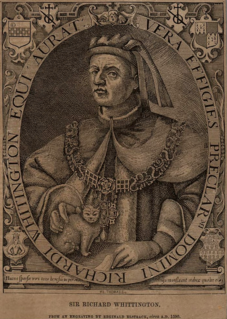Related Research Articles

Richard Whittington of the parish of St Michael Paternoster Royal, City of London, was an English merchant and a politician of the late medieval period. He is also the real-life inspiration for the English folk tale Dick Whittington and His Cat. He was four times Lord Mayor of London, a member of parliament and a Sheriff of London. In his lifetime he financed a number of public projects, such as drainage systems in poor areas of medieval London, and a hospital ward for unmarried mothers. He bequeathed his fortune to form the Charity of Sir Richard Whittington which, nearly 600 years later, continues to assist people in need.

Hugh Clopton was a Lord Mayor of London, a member of the Worshipful Company of Mercers and a benefactor of his home town of Stratford-upon-Avon in Warwickshire.
Robert Fabyan was a London draper, Sheriff and Alderman, and author of Fabyan's Chronicle.
Sir Richard Gardiner was, in 1478, elected Lord Mayor of London. He was Alderman of Walbrook Ward, and had been Sheriff of the City of London in 1469. He was also elected in 1478 a Member of Parliament for the City of London, one of the two aldermanic representatives of the city.

Farringdon Without is the most westerly Ward of the City of London, its suffix Without reflects its origin as lying beyond the City’s former defensive walls. It was first established in 1394 to administer the suburbs west of Ludgate and Newgate, and also around West Smithfield. This was achieved by splitting the very large, pre-existing Farringdon Ward into two parts, Farringdon Within and Farringdon Without. The large and prosperous extramural suburb of Farringdon Without has been described as having been London’s first West End.

Sir Henry Barton was twice Lord Mayor of London in the 15th century.

Sir Thomas Knollys or Knolles was an English businessman in London who was active in both local and national government.

Sir William Craven was an English merchant, Lord Mayor of London in 1610. It has been noted that the story of Dick Whittington has some similarities to Craven's career, though the story was first published before Craven became Lord Mayor.

Sir William Purdie Treloar, 1st Baronet was an English businessman who was Sheriff of London in 1889–1900 and Lord Mayor of London in 1906–1907. He established an active "Cripples' Fund" as his mayoral appeal.
Sir Ralph Warren was twice Lord Mayor of London, for the first time in 1536 and the second in 1543.
Sir Thomas Soame was an English politician who sat in the House of Commons from 1640 to 1648.

Sir Thomas Bennet was an English merchant and Lord Mayor of London in 1603-04.
Sir Henry Rowe was an English merchant who was Lord Mayor of London in 1607.
Sir Thomas Hayes was an English merchant who was Lord Mayor of London in 1614.
Sir Nicholas Rainton was an English merchant who was Lord Mayor of London in 1632.

Sir Thomas Pilkington was an English merchant, politician and Lord Mayor of London.
Sir William Browne served as Master of the Worshipful Company of Mercers from 1507 to 1514, and as alderman, auditor, Sheriff and Lord Mayor of London. He died in office on 3 June 1514 while serving his term as Lord Mayor.
Sir Francis Child the younger, of the Marygold, by Temple Bar, and Osterley Park, Middlesex, was a British banker and politician who sat in the House of Commons from 1722 to 1740. He was Lord Mayor of London in 1731.
Sir Edward Clarke, of Brickendon, Hertfordshire, was an English merchant who served as Lord Mayor of London in the year 1696 to 1697.
Sir Henry Marshall (1688–1754), of St. Mary at Hill, London and Theddlethorpe, Lincolnshire, was a British merchant and Tory politician who sat in the House of Commons from 1734 to 1754. He was Lord Mayor of London for the year 1744 to 1745
References
- 1 2 3 4 5 Lee 1887.
- ↑ "Chronological list of aldermen: 1302-1400". British History Online. Retrieved 7 October 2016.
- ↑ Durant, Will (1957). The Reformation. The Story of Civilization. 6. New York: Simon and Schuster. p. 124.
- ↑ Nicolas, Sir Nicholas Harris (1826). "Testamenta Vestuta".
- Attribution
 This article incorporates text from a publication now in the public domain : Lee, Sidney (1887). "Colet, Henry". In Stephen, Leslie (ed.). Dictionary of National Biography . 11. London: Smith, Elder & Co.
This article incorporates text from a publication now in the public domain : Lee, Sidney (1887). "Colet, Henry". In Stephen, Leslie (ed.). Dictionary of National Biography . 11. London: Smith, Elder & Co.